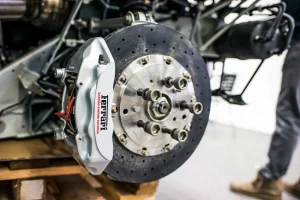Caring for Your Car’s Brakes


Caring for Your Car’s Brakes


Introduction
Properly maintaining your car’s brakes is essential for ensuring your safety on the road. Neglecting brake maintenance can lead to decreased braking performance, increased stopping distances, and even brake failure. In this article, we will discuss some important steps and tips to help you care for your car’s brakes and keep them in optimal condition.
Regular Inspections
One of the first steps in caring for your car’s brakes is to conduct regular inspections. Here’s how you can do it:
- Visual Inspection: Start by visually inspecting your brake components. Look for any signs of wear, such as thinning brake pads or uneven rotor surfaces. Check for any leaks or corrosion on the brake lines and calipers.
- Listen for Unusual Noises: Pay attention to any unusual noises when applying the brakes, such as squealing, grinding, or metallic sounds. These noises may indicate worn-out brake pads or damaged rotors that need immediate attention.
- Check Brake Fluid: Inspect the brake fluid reservoir to ensure it’s at the proper level. If the fluid appears dirty or discolored, it may be a sign that it needs to be replaced.
Brake Pad Replacement
Brake pads are a critical component of your car’s braking system, and they will wear out over time. Here’s how you can replace them:
- Gather the Necessary Tools: You will need a lug wrench, a jack, jack stands, a C-clamp, and a set of new brake pads.
- Prepare the Car: Park your car on a flat surface and engage the parking brake. Loosen the lug nuts on the wheels but do not remove them just yet.
- Lift the Car: Use a jack to lift the car off the ground and secure it with jack stands for added safety.
- Remove the Wheels: Completely remove the lug nuts and take off the wheels to access the brake caliper.
- Remove the Brake Caliper: Locate the brake caliper and remove the bolts holding it in place. Carefully slide the caliper off the rotor and suspend it using a wire or bungee cord to avoid putting strain on the brake line.
- Replace the Brake Pads: Take out the old brake pads and use a C-clamp to compress the caliper piston fully. Install the new brake pads into the caliper.
- Reinstall the Brake Caliper: Slide the caliper back onto the rotor and secure it with the bolts. Ensure the caliper is properly aligned before tightening the bolts.
- Put the Wheels Back On: Remount the wheels onto the car and hand-tighten the lug nuts. Lower the car back to the ground and use a torque wrench to tighten the lug nuts to the manufacturer’s specifications.
Brake Fluid Maintenance
Proper brake fluid maintenance is crucial for optimal brake performance. Follow these steps to maintain your brake fluid:
- Check the Owner’s Manual: Refer to your car’s owner’s manual to determine the recommended brake fluid type and the interval for fluid replacement.
- Locate the Brake Fluid Reservoir: Open the hood of your car and locate the brake fluid reservoir. It is typically located near the firewall on the driver’s side.
- Inspect the Brake Fluid: Check the brake fluid level and ensure it is between the minimum and maximum marks on the reservoir. If it is low, add the recommended brake fluid to bring it to the correct level.
- Replace the Brake Fluid: If the brake fluid appears dirty or discolored, it is recommended to have it replaced. Brake fluid replacement is best done by a professional mechanic who can perform a complete flush of the system.
Driving Habits and Brake Care
Your driving habits can also impact the lifespan and performance of your brakes. Here are some tips to keep in mind:
- Avoid Heavy Braking: Try to avoid heavy and sudden braking whenever possible. Gradual braking allows the brake pads to wear more evenly and reduces strain on the braking system.
- Maintain a Safe Following Distance: Maintain a safe distance from the vehicle in front of you to avoid sudden stops or the need for aggressive braking.
- Coast When Possible: Anticipate stops and coast when approaching red lights or stop signs. This reduces the need for heavy braking.
- Avoid Overloading: Do not exceed the maximum load capacity of your vehicle. Overloading puts additional strain on the brakes and can lead to premature wear.
Conclusion
Caring for your car’s brakes is a critical aspect of vehicle maintenance and safety. Regular inspections, brake pad replacements, brake fluid maintenance, and mindful driving habits are all essential for keeping your brakes in optimal condition. By following the steps outlined in this article, you can ensure that your car’s brakes perform reliably when you need them most. Remember, if you’re unsure about any aspect of brake maintenance, it’s always best to consult a qualified mechanic for assistance. Stay safe on the road!








